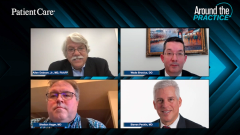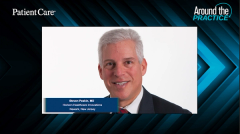
Case 2: Prevention of Diabetic Retinopathy in a Patient with Type 2 Diabetes
Allen Dobson, Jr., MD, FAAFP, reviews the case of a 49-year-old woman with type 2 diabetes and the panel comments on their approaches to continued care and disease prevention.
Episodes in this series

Allen Dobson, Jr., MD, FAAFP: Let’s do another case. This one is simple, but you’ll understand why I’m asking the question. You’ve got a 49-year-old woman newly diagnosed with type 2 diabetes who’s in your office for a regular check, and you do the typical eye exam. Her type 2 diabetes is reasonably controlled. Her A1C [glycated hemoglobin] is 7%. You put them into your established plan for continued care. But what do you say to them about what they need to know about the prevention of vascular complications, including diabetic retinopathy? What are your talking points? Because typically when someone has diabetes, it’s hard to get them to understand the potential long-term effects if they don’t take it seriously. Are there any tricks of the trade to make sure your patients understand the importance of follow-up and screening?
Wade Brosius, DO: From my perspective, I tell people, “This isn’t a sugar disease,” because that’s what a lot of people think. I explain very clearly that it’s a blood vessel disease. I break it down into big blood vessels and little blood vessels. Big blood vessels mean you’re at greater risk for heart attack and stroke. With little blood vessels, you’re at greater risk for the enduring complications from diabetes, predominantly eyes, kidneys, and nerves. By telling them that way, they understand the importance. Because quite honestly, all the national guidelines are more stringent and approximate those patients who already have known cardiovascular disease states. You have to have a better TITRE [time at target] blood pressure and better LDL [low-density lipoprotein] control.
And then I stress to them, as Shelton articulated well before, that it’s important to make sure they get their retinal screenings done annually because the very beginning part of this is that you’ll be asymptomatic. The other kicker with this is that this young woman is only 49 years old. Statistically, if she has diabetes for 15 years or more, her rate of risk for diabetic retinopathy goes up tremendously. That’s how I approach it, but I’m a pretty simple guy.
Steven Peskin, MD: One intervention I’d highlight that we’ve had some success with is peer coaching. If a 50-year-old Central American woman is talking to another 50-year-old Central American woman, they may be able to break through, whereas the physician may not have the same language and nuance. Most physicians are good at establishing trust with their patients, but there’s something to be said for peers as far as motivating people.
Allen Dobson, Jr., MD, FAAFP: Do any of you get out and talk to groups? That used to be common, Shelton remember, in residency. We’d make a huge effort to go to churches and places where there were peer groups and have discussions. This seems like an opportunity to make people aware of not just diabetes but more specifically diabetic retinopathy. It’s like going back to the future, doing some of the things that we used to do that health care and COVID-19 have taken us away from. It’s certainly an opportunity.
Shelton Hager, MD: One of the other things you could talk to an asymptomatic patient about is how long they want to continue to feel asymptomatic. In order to continue to feel this way and not have problems, it means keeping your blood pressure and sugar under control and doing these preventive things. That way we can have the same conversation hopefully 30 years from now.
Allen Dobson, Jr., MD, FAAFP: Good point.
Transcript Edited for Clarity
Newsletter
Enhance your clinical practice with the Patient Care newsletter, offering the latest evidence-based guidelines, diagnostic insights, and treatment strategies for primary care physicians.























































































































































































































































































